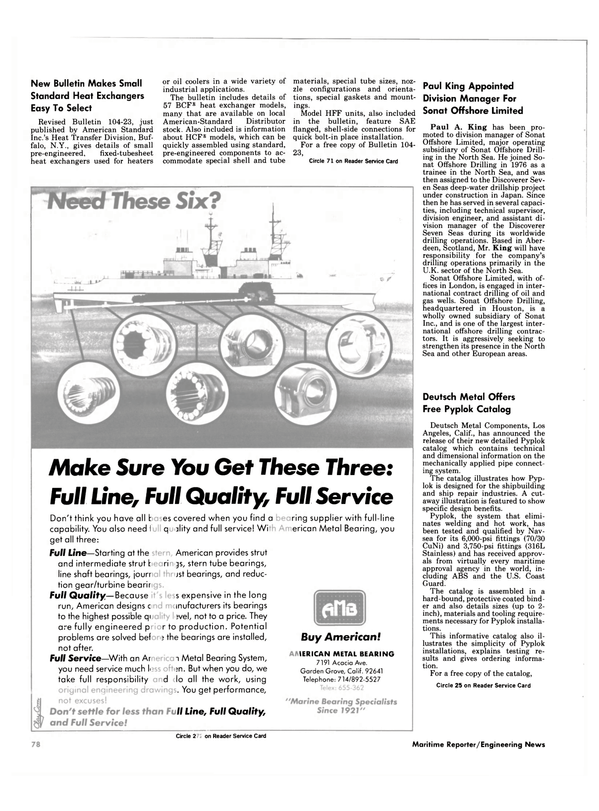
New Integrated Navigation & Command System From Krupp Atlas Elektronik
Nacos 20, a new computerized integrated navigation and command multi-processing system for the optimization of navigation and bridge control of both standard and specific purpose vessels, has been announced by Krupp Atlas Electronik.
Integrating a series of navigational sensors and an autopilot within one modular work station consisting of standardized modules, interfaces and operational procedures, it is designed to realize precision navigation at reduced cost while improving overall levels of safety.
A basic configuration comprises two of the latest Atlas Rasterscan radars, the 8600 ARPA and either a 7600 TM or ARPA unit, which are the only systems to offer continuous true daylight rasterscan viewing on a 16-inch screen; a doppler log; an echosounder; an Adaptive Radar Controlled Autopilot (ARCAP), for which the 8600 ARPA additionally provides input and monitoring functions; and a central control console embodying a full-color Navigation Information Display (NID), together with interfaces for other sensors and bridge equipment.
Among key functions fulfilled by the system are determination of actual position from up to three inde- pendent primary sensors such as Loran C, Decca and Satnav, in association with an Atlas doppler log and a standard gyro system. Longterm route planning for deep sea operations by waypoint input and short-term maneuvering and track planning in coastal waters are also possible, the latter using predictive input from the 8600 ARPA.
Other main functions include automatic track control via either the 8600 or ARCAP facility, with error limits and alarms depending on the precise operational mode; collision and avoidance alarm together with comprehensive, easily assimilated indicaton of navigational and other ship's data on the NID. Using a common data bus, the system also provides for functional integration of other ship's systems such as those for administration, communications, engine control and centralized monitoring. Its flexible design concept additionally allows for integration of future generations of navigational equipment, including the Navstar GPS.
Primary aims of the system are directed towards the consolidation and control of both routine and specific data from various sources for central display at a console designed for one-man operation. A decentralized, redundant processing of operational data principle is employed in which various key function areas are grouped organically and provided with relevant hardware for processing, operation and display.
Incorporating extensive on-line self-test facilities and designed to comply with DoT, DHI, USCG and other leading specifications, NACOS 20 provides simple costeffective installation and integration with other systems in a ship while also allowing for reduced cost for overall system maintenance and personnel training.
Partly developed under sponsorship of the West Germany Ministry of Research and Technology's "Ship of the Future" project, a system is scheduled for installation on Krupp Atlas Elektronik's own research vessel, MS "Schall", this December.
Three configurations have also been ordered by a leading Norwegian owner for new PROBO carriers presently undergoing construction in South Korea.
For a complete literature package describing the new system in full detail, Circle 27 on Reader Service Card
Read New Integrated Navigation & Command System From Krupp Atlas Elektronik in Pdf, Flash or Html5 edition of November 1984 Maritime Reporter
Other stories from November 1984 issue
Content
- USS Iowa (BB-61) page: 4
- Saint John Shipbuilding Appoints Snyders VP And Manager, Shipbuilding Div. page: 5
- Greller and Belt Promoted At Ashland Petroleum page: 5
- Western Gear Relocates Corporate Headquarters To South Milwaukee page: 5
- Veson Computer Systems Offers Free Literature On Shipping Programs page: 6
- Webb Institute To Hold Annual Alumni Banquet page: 6
- Giannotti Awarded Contract For Ocean Thermal Study And Conceptual Design page: 6
- McLean Urges American Shipping Community To Remain Competitive page: 6
- Allen Named Director Of MDTSCO Washington Operations Divison page: 7
- Flint & Mercer Named Senior Vice Presidents For Eller & Company page: 7
- C. Plath And Racal Marine Controls Sign Cooperation Agreement page: 7
- Sandusky Offers Brochure On Centrifugal Castings page: 7
- MarAd Awards $4,250,848 In Contracts To Improve Productivity of U.S. Yards page: 8
- Braden Winch Marketing New Planetary Hoist page: 8
- Killian Named VP Of H.O. Penn Power Div. page: 8
- Watterworth Appointed Vice President-Operations For General Steamship page: 8
- Oil Content Monitor Offered By Salwico page: 9
- Drew, DHL In Agreement For Worldwide Port Fuel Evaluation Servic page: 10
- B&W And Flight Safety Form New Joint Venture Training Company page: 10
- Hoch Promoted At Comsat TeleSystems page: 10
- WABCO Forms Worldwide Parts And Service Network page: 10
- Rothermel Named Sales Vice President For Comsat TeleSystems page: 11
- Bay Shipbuilding Awarded $l 80-Million Contract To Build Three Containerships For Sea-Land page: 11
- Cable Splicing System Lowers Shipbuilding Costs page: 12
- Evans Appointed Vice President of ODECO page: 12
- U.S. NAVY SHIP OVERHAUL MARKET First Update — Changes As Of October 1984 page: 12
- Literature Available On Sperry's New Deepwater Navigation System page: 14
- Literature Available on New Ultra-Long-Stroke Diesel From M.A.N.-B&W page: 14
- 21 New Members Elected To ABS page: 15
- Mitsubishi Kakoki Offers New Products For Solving The Fuel Quality Problem page: 18
- Promotions Announced By Consolidated Grain page: 18
- Alden Introduces New Facsimile Transceiver page: 20
- Brown Named Director Of Marketing For Seaward International page: 20
- IMODCO Awarded Contract By Esso Suez For Mooring Terminal Offshore Egypt page: 22
- WABCO Introduces New Pneumatic Control Valve page: 22
- Moody-Tottrup Brochure Available On Offshore And Marine Industry Services page: 24
- CEC Awarded $2.5-Million Contract For Ship Unloader page: 24
- Mirrlees Blackstone Moves Into New Houston Facility page: 24
- Siwertell Develops New Design For Floating Bulk Transfer Station page: 26
- Richards & Associates Named Representative For Asea Marine's Line page: 26
- Nichols Brothers Boat Builders Christens Second Passenger Catamaran page: 28
- ABS Elects Gillies Vice President page: 28
- Racor Offers Literature On Its N e w Spin-On Fuel Filter/Water Separator page: 29
- Airco Introduces New Pulsed Welding Systems page: 29
- Bender Delivers Tour Boat 'Amarya' To Nigerian Government page: 30
- Sperry Introduces New 340-mm Radar, New Autopilot, And 'Marinized' PC page: 30
- Meyer Werft Launches One And Delivers Another Passenger Ship For Indonesian Inter-Island Service page: 32
- Twin Matson Container Barges Christened At McDermott Shipyard page: 32
- Renk Offers Reference List Of Marine Gear Units Used In Naval Vessels page: 32
- Aegis Cruiser "Valley Forge' Christened At Ingalls Shipyard page: 33
- Racor Offers Literature On Its Self-Regulating Diesel Fuel Line Heater page: 33
- Renk Offers Literature On RCF Generator Gears page: 33
- Alexander Industries Named Agent For Clow/Greenberg page: 33
- Kidde Offers Free Brochure On Total Fire Protection page: 33
- The Angel Of Competition page: 34
- Mctgnavox Introduces Civil Global Positioning System page: 36
- IMODCO Awarded Contract By Esso Suez For Mooring Terminal Offshore Egypt page: 36
- Eastern Marine Signs Contract For Passenger/Auto Ferry page: 37
- Blount Marine Yard Completes High-Speed Commuter Vessel page: 41
- Free Eight-Page Brochure Available From Racor page: 41
- Browning Named Contracts And Sales Vice President For Sonat Offshore Drilling page: 42
- Valmet Delivers First Of Four Supply Vessels To Soviet Union page: 42
- MarAd Submits Final Rule For Governing Evaluation Of Bids page: 43
- New Krupp Atlas ARPA Gets British DoT Type Approval page: 43
- Wartsila Turku Yard Delivers Big Catamaran Crane Vessel To USSR page: 44
- 92nd SNAME Annual Meeting Third International Maritime Exposition page: 46
- Dyvi Heavy Lift Vessel Busy Transporting Semisubmersibles page: 47
- RFD Survival Liferaft Line Gains Davit-Launch Approval page: 47
- Peck & Hale Offers Container Lashing System Literature page: 62
- AMMCO Enters License Agreement With Damen Shipyards Of Holland page: 64
- New Pipe Connecting System Reduces Costs page: 64
- Bender Christens And Launches Cruiser "Pilgrim Belle' page: 66
- New Literature Sheet Describes Simpson's Seaworthy Panel Products page: 68
- Continental Maritime Gets $18-Million Navy Contract For Crane Ship Conversion page: 68
- Three Offshore Service Fleets Plan Merger Into New Company page: 71
- Regency Introduces New Marine Transceiver page: 71
- Hydranautics Awarded Contract By Marathon Oil For Rig-Skidding Systems page: 71
- Western Gear To Build And Sell Rademakers Epicyclic Transmissions page: 72
- New Integrated Navigation & Command System From Krupp Atlas Elektronik page: 74
- Harbormaster Offers Free 8-Page Brochure On Propulsion Units page: 74
- Korea's Samsung Shipyard Offers 24-Page Brochure On Facilities, Capabilities page: 74
- Tl Has A New Fleet Management System To Improve Vessel Operating Efficiency page: 77
- N e w Bulletin M a k e s Small S t a n d a r d Heat Exchangers Easy To Select page: 78
- Paul King Appointed Division Manager For Sonat Offshore Limited page: 78
- Deutsch Metal Offers Free Pyplok Catalog page: 78
- New Brochure Describes John Crane Maintenance Training Center page: 80
- Gulf Oil Offers Free Full Color Guide To Marine Lubricants page: 80
- Farmer Named Worldwide Operations Manager For Sonat Offshore Drilling page: 82
- Ferrous Announces FMS, System For Administering Catalyst Into Fuel Oil page: 82
- New York Port Engineers Meeting Hears Paper on Computer Uses page: 83
- DIRECTORY U.S. NAVY BUYING OFFICES page: 84
- Cummins Introduces New Premium Grade Lube Oil For Diesel Engines page: 99
- Devoe Marine Announces Management Appointments page: 100
- ABS Publishes Its First Guide For Certification Of Thrusters page: 102
- SKF Steel Introduces New Simplified Coupling page: 103
- Holmatro Offers Brochure Showing Full Product Line page: 103
- Gladding-Hearn Delivers 76-Foot Offshore Lobster Boat page: 104
- Marine Engineers Shipyard Gets Contract To Build Schooner page: 107
- GM Engines Pass Offshore Tilt Test—Literature Available page: 112
- Flexaust Announces A Major Improvement In Its Product Line page: 113
- Design Manual Available On Teleflex Remote Mechanical Valve Actuator page: 113
- Lisnave Will Continue Technical Support To ASRY In Bahrain page: 119
- Du Pont Offers Free Brochure On New "Offshore Maintenance Painting Service' Program page: 119


